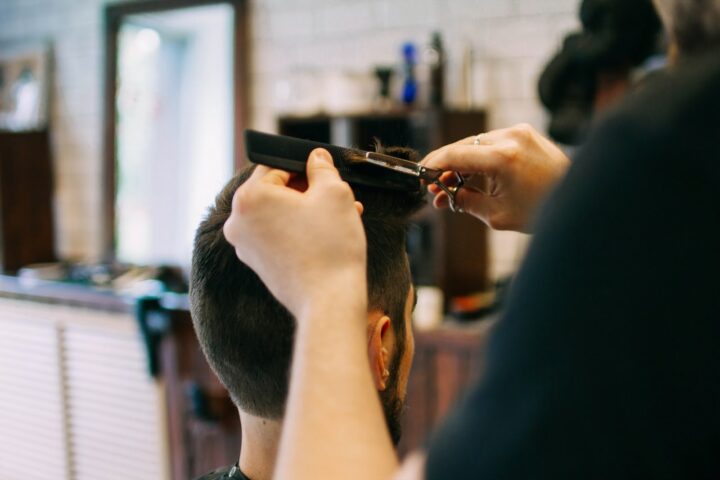A Comprehensive Hair Cutting Guide For Beginners
Hair cutting is an art, a skill that can transform a person’s appearance and boost their confidence. Whether you’re considering a career in hairstyling or you simply want to experiment with your hair, embarking on the journey of haircutting can be both exciting and intimidating.
As a beginner, there’s much to learn and practice, but fear not! In this comprehensive guide, we will walk you through the essentials of haircutting, from the importance of adequate training to the proper use of haircutting scissors and so much more. So, let’s get started!

1. Getting Adequate Training: The Foundation of Hair Cutting
Before you dive into the world of haircutting, it’s crucial to understand the significance of proper training. Adequate training provides you with the fundamental knowledge of various hair-cutting techniques, safety precautions, and the art of creating stunning hairstyles. To begin, consider enrolling in a reputable cosmetology or barber school.
These institutions offer comprehensive programs that cover everything from the basics to advanced cutting techniques. Additionally, many online courses and tutorials are available, making it easier than ever to acquire the skills you need. Investing in a solid educational foundation will empower you to create beautiful haircuts with confidence.
2. The Essential Tools of the Trade
One of the most critical aspects of becoming a successful haircutter is acquiring the right tools. The primary instrument in your arsenal is the haircutting scissors, so it’s essential to know how to use them effectively. When you learn to hold haircutting scissors, you’re not just holding a tool; you’re wielding the key to your craft. Proper scissor handling is crucial for precision, control, and the overall quality of your haircuts.
Many beginners often overlook this step, but it’s essential to practice holding your scissors correctly. Remember to hold the handles with your thumb and ring finger, while the middle finger supports the blade, allowing for precise and comfortable cutting. Always ensure your scissors are sharp to avoid unnecessary tugging or uneven cuts.
3. Understanding Hair Types and Textures
To excel in hair cutting, it’s imperative to comprehend the various hair types and textures you’ll encounter. Hair varies from person to person, and a one-size-fits-all approach simply won’t cut it (pun intended). Straight hair, curly hair, wavy hair, fine hair, and coarse hair all require distinct cutting techniques.
For instance, cutting curly hair while it’s dry can result in a different outcome compared to cutting it while wet. Being able to identify these differences and adjust your cutting methods accordingly is a hallmark of a skilled hair cutter.
4. Choosing the Right Haircutting Techniques
As a beginner, it’s essential to start with the basics before venturing into more complex techniques. Some of the fundamental haircutting methods include blunt cuts, layering, and texturizing. Blunt cuts create a straight, even line and are suitable for achieving a polished look. Layering, on the other hand, adds depth and movement to the hair, making it a versatile technique.
Texturizing is used to remove excess bulk and create a softer, textured finish. These techniques are the building blocks of hair cutting, and mastering them will provide you with a strong foundation for more intricate styles.
5. Safety First: Hygiene and Sanitation
Proper hygiene and sanitation are non-negotiable in the world of haircutting. As a beginner, it’s essential to develop good habits from the start. Always ensure that your hands and tools are clean and disinfected before working with a client or on your hair.
Hair cutting can create tiny clippings that may carry bacteria or other contaminants, so maintaining a clean workspace is vital to prevent infections and allergic reactions. Safety also extends to the client’s comfort and safety. Be mindful of their posture, and any allergies or sensitivities, and ensure that the haircutting process is a pleasant experience.
6. Practice, Patience, and Perseverance
Becoming proficient in haircutting is a journey that requires practice, patience, and perseverance. Don’t be discouraged by early mistakes; they are an essential part of the learning process. Practice on mannequins or willing friends and family members to refine your skills. Remember that each haircut you complete brings you one step closer to mastery. Continuously seek feedback and constructive criticism to improve. Be patient with yourself and stay committed to honing your craft, and in time, you’ll see remarkable progress.
Becoming a proficient hair cutter as a beginner is a process that involves learning, practice, and dedication. Whether you aspire to become a professional hairstylist or want to enhance your hair-cutting skills for personal use, this comprehensive guide has provided you with a solid foundation.
Remember that mastering the art of haircutting is an ongoing journey, and with the right training, tools, and mindset, you can create beautiful and transformative hairstyles for yourself and others. So, grab your haircutting scissors, embark on this exciting journey, and let your creativity shine through your craft. Happy cutting!


